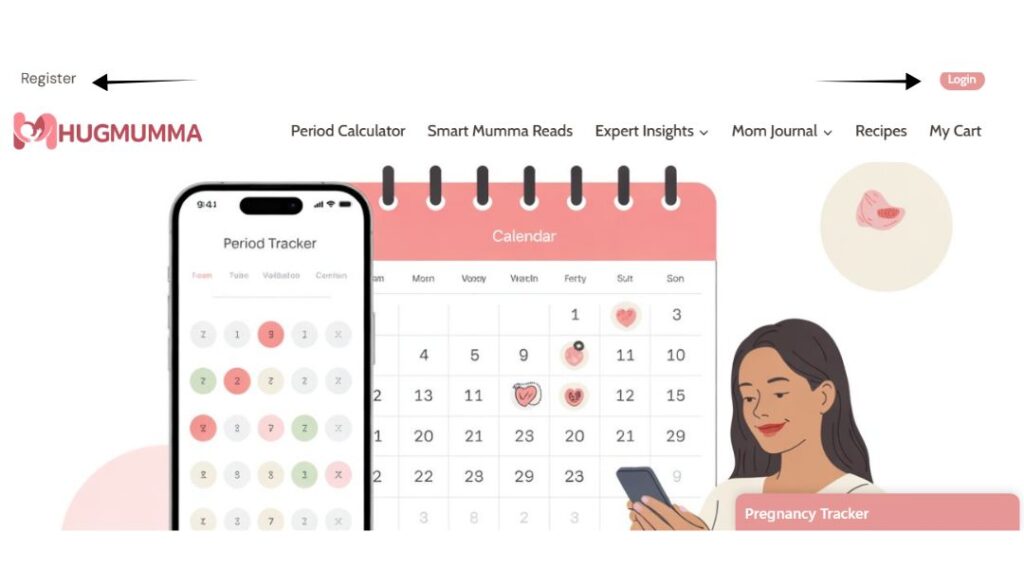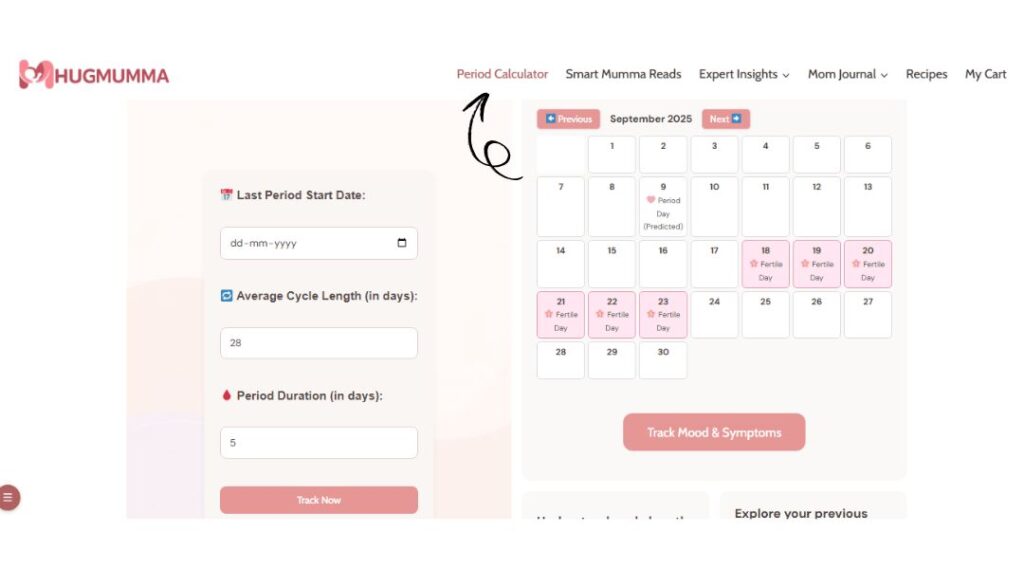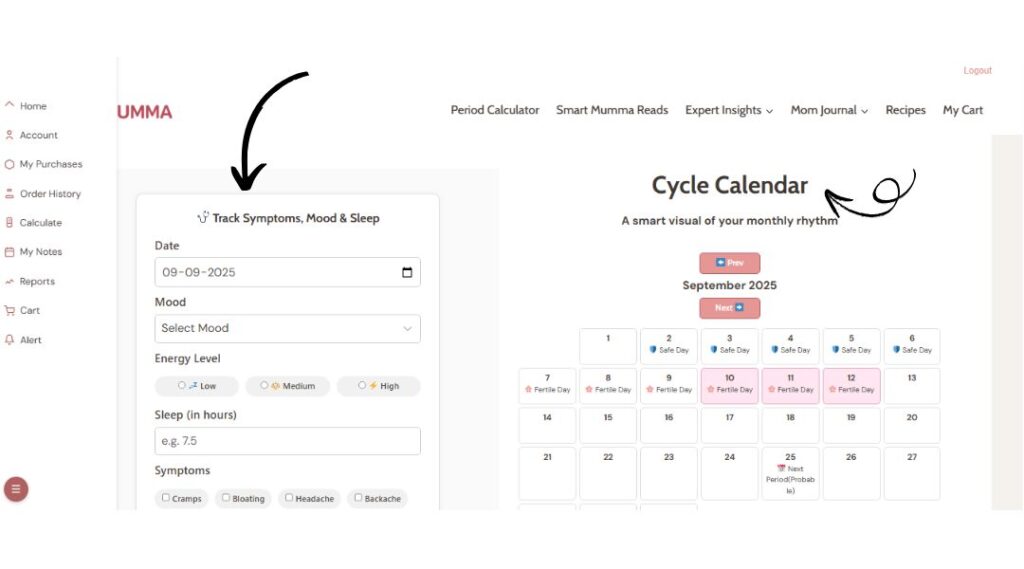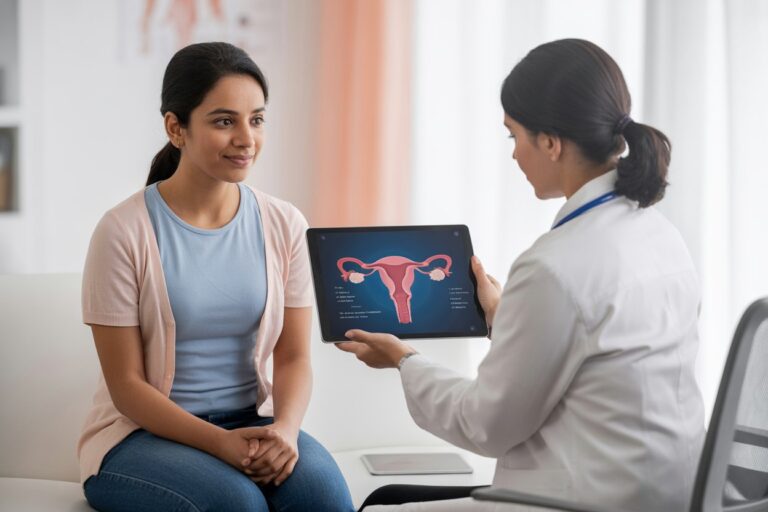Understanding your body is one of the most powerful things you can do on your fertility journey. Many women wonder how to track ovulation without relying on expensive ovulation kits. The good news is that your body already gives you signs — you just need to learn how to read them. By paying attention to natural indicators such as cervical mucus, basal body temperature, and cycle patterns, you can predict ovulation and increase your chances of conception.
At HugMumma, we’ve also built a free period and ovulation tracker that helps women log their cycles, fertile days, and notes, making the process simpler and stress-free.
Why Learning How to Track Ovulation Matters
Ovulation is the release of an egg from your ovary, usually occurring once in every menstrual cycle. If you’re trying to conceive, this is your most fertile window. But even if pregnancy isn’t your current goal, knowing how to track ovulation can help you understand your cycle better, manage PMS symptoms, and take charge of your reproductive health.
Tracking ovulation doesn’t have to mean buying costly test kits or fancy devices. With body awareness and some free tools, you can become your own fertility detective.
Understanding Your Menstrual Cycle
Before we dive into how to track ovulation, it’s important to understand what actually happens in a menstrual cycle. Your cycle is more than just “period days” — it’s a beautifully coordinated process that prepares your body each month for the possibility of pregnancy. Here’s a breakdown of the four main phases:
Day 1: Menstrual Phase (Period Days)
The cycle begins on the first day of your period, which is counted as Day 1. This is when the lining of the uterus (endometrium), which had built up in the previous cycle, is shed because pregnancy did not occur. Bleeding usually lasts between 3–7 days, though it can vary for each woman.
- Hormones involved: Estrogen and progesterone are at their lowest.
- What you may feel: Fatigue, cramps, mood changes, or low energy.
- Why it matters: This phase resets your body and starts preparing for the next cycle.
Follicular Phase (Day 1 to around Day 13)
The follicular phase overlaps with your period and continues until ovulation. During this phase, the pituitary gland releases follicle-stimulating hormone (FSH), which encourages several ovarian follicles (tiny sacs containing eggs) to mature. Usually, one dominant follicle emerges and prepares to release an egg.
- Hormones involved: Estrogen levels begin to rise, stimulating growth of the uterine lining.
- What you may feel: Gradually increasing energy, clearer skin, and a more positive mood as estrogen rises.
- Why it matters: A healthy follicular phase ensures that the egg matures properly and the uterus is prepared for implantation if conception happens.
Ovulation (Around Day 14 in a 28-Day Cycle)
This is the star event of the cycle. Triggered by a surge in luteinizing hormone (LH), the mature egg is released from the ovary and travels into the fallopian tube, where it may meet sperm for fertilization.
- Hormones involved: LH surge + peak in estrogen.
- What you may feel: Slight pelvic discomfort (mittelschmerz), increase in cervical mucus (clear, stretchy, egg-white consistency), higher libido, or subtle changes in senses like smell.
- Why it matters: This is your most fertile window. The egg survives about 12–24 hours, but sperm can live in the reproductive tract for up to 5 days, which is why the fertile window is about 5–6 days around ovulation.
Luteal Phase (Day 15 to Day 28)
After ovulation, the empty follicle transforms into the corpus luteum, which releases progesterone to maintain the uterine lining in case pregnancy occurs.
- Hormones involved: Progesterone rises, estrogen remains moderate.
- What you may feel: Breast tenderness, bloating, mood swings, increased appetite, or PMS symptoms as hormones fluctuate.
- If pregnancy happens: The fertilized egg implants, and progesterone remains high.
- If pregnancy does not happen: The corpus luteum breaks down, progesterone drops, and the uterine lining is shed — bringing on your next period.
Why This Matters for Tracking Ovulation
In a typical 28-day cycle, ovulation occurs around Day 14, but cycles can be shorter (21 days) or longer (35+ days). That’s why relying only on averages can be misleading. Personalized methods — like observing cervical mucus, checking basal body temperature, or using tools like the HugMumma Period & Ovulation Tracker — help you pinpoint ovulation more accurately, even if your cycle isn’t perfectly regular.
How to Track Ovulation – HugMumma Period & Ovulation Tracker
Learning how to track ovulation becomes much simpler when you use the HugMumma Period & Ovulation Tracker. Unlike disposable kits, our tracker grows smarter with your data and gives you a personalized cycle guide every month. Here’s how you can get started:
Step 1: Login/Register
Go to hugmumma.com and log in to your account. If you don’t have one, you can register in just a few clicks.

Step 2: Open the Tracker
Visit the Period Calculator page. This is where you’ll enter your cycle details.

Step 3: Enter Your Details
Fill in the required information:
- Last period date
- Average cycle length (for many women, it’s 28 days, but it can vary)
- Period duration (how many days your period usually lasts)
Step 4: Click on “Track Now”
Once you enter the details, hit the Track Now button. The tracker will instantly calculate your next periods, fertile days, ovulation date, and safe days.
Step 5: Save Your Entry
The calculated data will be displayed on the screen. Click on Save Entry to store your cycle information.

Step 6: Explore “My Notes”
You’ll be redirected to the My Notes section. Here you can:
- Track your mood, symptoms, or lifestyle notes.
- View a calendar that highlights fertile days and predicted ovulation dates.
- See all your saved period entries in one place for easy reference.
With consistent use, the HugMumma Tracker not only predicts your cycle but also helps you recognize long-term patterns, making it one of the most practical tools for women learning how to track ovulation naturally.


Cervical Mucus Changes – Nature’s Clue
One of the most natural and reliable ways to learn how to track ovulation is by paying attention to your cervical mucus. Cervical mucus (sometimes called cervical fluid or discharge) changes throughout your cycle in response to shifting hormone levels. Think of it as your body’s built-in fertility signal — it tells you when you’re fertile and when you’re not.
Here’s how it usually looks across different stages of the cycle:
After Your Period (Dry Days)
Once menstrual bleeding stops, many women notice little to no discharge. The vagina may feel dry, and underwear may stay clean. This usually means you’re in the non-fertile phase of your cycle.
- Why: Hormones are still low, and your body hasn’t started preparing for ovulation yet.
- Tip: Don’t worry if these days feel inconsistent — some women have a short dry phase, while others notice light spotting or very minimal mucus.
Approaching Ovulation (Creamy or Sticky Discharge)
As estrogen begins to rise and your body prepares to release an egg, cervical mucus becomes noticeable. It may look white, creamy, or even slightly sticky to touch.
- Why: Estrogen makes the cervix produce more fluid, helping sperm survive longer in the vagina.
- Tip: This is the transition phase — fertility is increasing, but you’re not yet at peak fertile days.
During Ovulation (Egg-White Mucus)
This is the most fertile cervical mucus and the easiest to recognize. Around ovulation, discharge becomes clear, slippery, and stretchy — very similar to raw egg whites. If you can stretch it between your fingers, it’s a classic fertility sign.
- Why: High estrogen levels thin out the mucus, making it easier for sperm to travel through the cervix and reach the egg.
- Tip: When you see this type of mucus, your chances of conception are highest. This is your body’s way of saying, “Now is the right time.”
After Ovulation (Thick or Dry Again)
Once ovulation is over, progesterone rises, and cervical mucus changes again. It becomes thicker, tacky, or may even disappear completely. Many women feel drier during this time.
- Why: The body is no longer fertile, and the mucus acts as a barrier to sperm.
- Tip: This is the “safe” phase if you’re avoiding pregnancy naturally, though it should not be the only method of contraception.
Why Cervical Mucus Is a Reliable Clue
Unlike ovulation kits that give only a yes/no result, observing cervical mucus teaches you to understand your body’s natural rhythms. It’s free, simple, and can be done daily without any tools. Over time, you’ll start seeing a pattern that makes tracking ovulation much easier.
For added clarity, you can log your mucus changes in the HugMumma Period & Ovulation Tracker, which lets you record fertile signs, notes, and symptoms. This way, you’re combining observation with technology — making it easier to predict and confirm your fertile window.
Basal Body Temperature (BBT)
Your body temperature slightly shifts during your cycle. By charting it every morning before getting out of bed, you can track patterns over time.
- Before Ovulation: Slightly lower temperatures.
- After Ovulation: Progesterone causes a rise in temperature.
While BBT doesn’t predict ovulation in advance, it confirms when ovulation has already happened. Pairing this with cervical mucus observations gives a more accurate picture of how to track ovulation naturally.
Ovulation Symptoms You Should Notice
Not every woman experiences obvious ovulation symptoms, but for many, the body gives subtle signals when an egg is being released. Paying attention to these changes can make learning how to track ovulation much easier — especially if you don’t want to rely solely on calendars or kits.
Here are some common signs to look out for:
1. Mild Cramping or Twinges (Mittelschmerz)
Some women feel a dull ache or a sharp twinge on one side of the lower abdomen during ovulation. This sensation, known as mittelschmerz (German for “middle pain”), usually lasts from a few minutes to a couple of hours.
- Why it happens: The discomfort is thought to come from the ovary releasing an egg or from fluid irritation in the pelvic area.
- What to do: Track when this pain occurs month to month. If it lines up consistently with mid-cycle, it can be a very useful ovulation clue.
2. Breast Tenderness
Just like before a period, some women notice sore or sensitive breasts around ovulation. This happens because of hormonal changes, particularly the rise in progesterone after the egg is released.
- Why it happens: Hormones prepare the body for a potential pregnancy, which can affect breast tissue.
- What to do: Note when breast tenderness begins and ends in your cycle. Over time, you may see a pattern that matches your fertile days.
3. A Stronger Sense of Smell or Taste Changes
Hormonal shifts can heighten certain senses. Around ovulation, some women report a sharper sense of smell, altered taste preferences, or even food cravings.
- Why it happens: Estrogen peaks before ovulation, influencing brain chemistry and sensory perception.
- What to do: If you notice that perfumes, spices, or certain foods feel more intense mid-cycle, it may be your body’s way of signaling fertility.
4. Increase in Libido
Nature often gives a nudge when fertility is at its highest. Many women feel more interested in intimacy around ovulation.
- Why it happens: Rising estrogen and testosterone levels boost sexual desire during the fertile window.
- What to do: While this sign alone isn’t enough to confirm ovulation, when paired with other symptoms (like cervical mucus or cramping), it’s a reliable part of the bigger picture.
Other Possible Symptoms
Every woman’s experience is unique, and you may notice additional changes such as:
- Slight bloating or water retention.
- Light spotting or discharge tinged with pink.
- Mood changes or bursts of energy.
Making the Most of These Signs
The key is consistency. One symptom alone may not mean much, but when you observe two or three signs together — say, cervical mucus changes, mild cramping, and higher libido — it strongly suggests ovulation is happening.
Logging these details in the HugMumma Mood and Symptoms Tracker can help you see patterns over several months. The more cycles you track, the clearer your body’s unique fertility signals become.
Lifestyle Habits That Support Tracking
While discovering how to track ovulation is key, your lifestyle also plays a role in cycle regularity. Simple changes can make your tracking journey smoother:
- Maintain a healthy weight — extremes in weight can affect ovulation.
- Manage stress with yoga, meditation, or journaling.
- Eat nutrient-rich foods that support hormone balance.
- Sleep well — irregular sleep can disrupt your cycle signals.
A healthy lifestyle not only improves fertility but also makes tracking more predictable.
When to See a Doctor
If you’ve been learning how to track ovulation for several months but find your cycles too irregular or don’t notice fertile signs, it may be wise to consult a gynecologist. Conditions like PCOS, thyroid imbalance, or hormonal irregularities can affect ovulation.
Early guidance from an expert can help you combine medical advice with natural tracking methods.
Key Takeaway
You don’t need expensive kits to understand how to track ovulation. Your body offers clear, natural signs — cervical mucus, basal body temperature, physical symptoms, and cycle patterns — all of which you can monitor for free. Pair these with the HugMumma Period & Ovulation Tracker, and you’ll have a reliable, stress-free way to take control of your reproductive health.
By tuning into your body and combining observation with simple digital tools, you can confidently know your fertile days without spending extra money.








One Comment